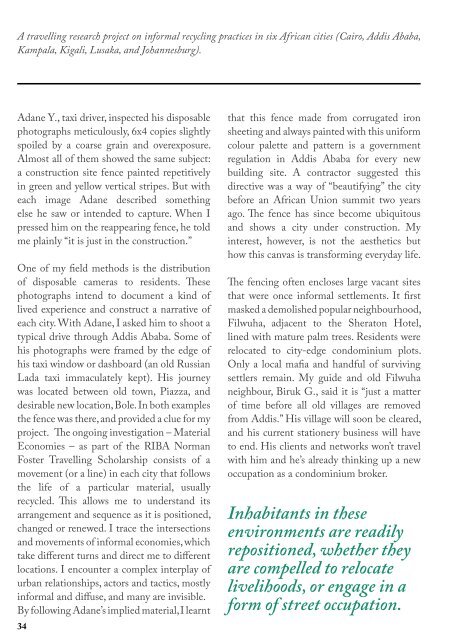ArchiAfrika-April-Magazine-English-final-v2
ArchiAfrika-April-Magazine-English-final-v2
ArchiAfrika-April-Magazine-English-final-v2
Create successful ePaper yourself
Turn your PDF publications into a flip-book with our unique Google optimized e-Paper software.
A travelling research project on informal recycling practices in six African cities (Cairo, Addis Ababa,<br />
Kampala, Kigali, Lusaka, and Johannesburg).<br />
Adane Y., taxi driver, inspected his disposable<br />
photographs meticulously, 6x4 copies slightly<br />
spoiled by a coarse grain and overexposure.<br />
Almost all of them showed the same subject:<br />
a construction site fence painted repetitively<br />
in green and yellow vertical stripes. But with<br />
each image Adane described something<br />
else he saw or intended to capture. When I<br />
pressed him on the reappearing fence, he told<br />
me plainly “it is just in the construction.”<br />
One of my field methods is the distribution<br />
of disposable cameras to residents. These<br />
photographs intend to document a kind of<br />
lived experience and construct a narrative of<br />
each city. With Adane, I asked him to shoot a<br />
typical drive through Addis Ababa. Some of<br />
his photographs were framed by the edge of<br />
his taxi window or dashboard (an old Russian<br />
Lada taxi immaculately kept). His journey<br />
was located between old town, Piazza, and<br />
desirable new location, Bole. In both examples<br />
the fence was there, and provided a clue for my<br />
project. The ongoing investigation – Material<br />
Economies – as part of the RIBA Norman<br />
Foster Travelling Scholarship consists of a<br />
movement (or a line) in each city that follows<br />
the life of a particular material, usually<br />
recycled. This allows me to understand its<br />
arrangement and sequence as it is positioned,<br />
changed or renewed. I trace the intersections<br />
and movements of informal economies, which<br />
take different turns and direct me to different<br />
locations. I encounter a complex interplay of<br />
urban relationships, actors and tactics, mostly<br />
informal and diffuse, and many are invisible.<br />
By following Adane’s implied material, I learnt<br />
that this fence made from corrugated iron<br />
sheeting and always painted with this uniform<br />
colour palette and pattern is a government<br />
regulation in Addis Ababa for every new<br />
building site. A contractor suggested this<br />
directive was a way of “beautifying” the city<br />
before an African Union summit two years<br />
ago. The fence has since become ubiquitous<br />
and shows a city under construction. My<br />
interest, however, is not the aesthetics but<br />
how this canvas is transforming everyday life.<br />
The fencing often encloses large vacant sites<br />
that were once informal settlements. It first<br />
masked a demolished popular neighbourhood,<br />
Filwuha, adjacent to the Sheraton Hotel,<br />
lined with mature palm trees. Residents were<br />
relocated to city-edge condominium plots.<br />
Only a local mafia and handful of surviving<br />
settlers remain. My guide and old Filwuha<br />
neighbour, Biruk G., said it is “just a matter<br />
of time before all old villages are removed<br />
from Addis.” His village will soon be cleared,<br />
and his current stationery business will have<br />
to end. His clients and networks won’t travel<br />
with him and he’s already thinking up a new<br />
occupation as a condominium broker.<br />
Inhabitants in these<br />
environments are readily<br />
repositioned, whether they<br />
are compelled to relocate<br />
livelihoods, or engage in a<br />
form of street occupation.<br />
34 35


